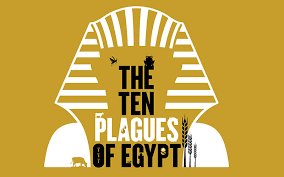The Ten Plagues of Egypt
7:14 to 12:36

Although there were ten plagues in all, the tenth was climactic and is therefore described at greater length from 11:1 to 12:30. The narrative of the tenth plague is interwoven with the account of the institution of the Passover in 12:1-28. The plagues continued for many months, so there was time in between each plague for Pharaoh to reflect on his decisions.
The story of the plagues is summarized in Psalm 78:22-51, where six of them are mentioned specifically (though not in chronological order): the blood, the flies, the frogs, the locusts, the hail, and the death of the firstborn. The story is also summarized in Psalm 105:28-36, where this time eight plagues are mentioned (again, not in chronological order): the darkness, the blood, the frogs, the flies, the gnats, the hail, the locusts and the death of the firstborn. In both psalms, the plague of the firstborn is mentioned last to stress its climactic importance. In Psalms 135:8 and 136:10, it is the only plague referred to at all, apparently because its story in Exodus made a much greater impression on later generations than the accounts of the other plagues. The tenth plague can therefore stand for all the plagues because it was the most astounding and destructive of them all.107
The progressive nature of these plagues is easily seen. There is a steady advance in the severity of the divine judgments. The first three merely interfered with the comfort of the Egyptians. First, they were deprived of water to drink and wash in. In the second, their homes were invaded with frogs. Thirdly, they were attacked with gnats. In the second three, the LORD’s hand was laid upon their possessions. First, flies corrupted their land. Secondly, their livestock was destroyed. Thirdly, boils broke out on the Egyptians and their animals. The last set of three plagues brought desolation and death. First, hail destroyed both the livestock and every growing thing in the fields. Secondly, the locusts devoured even what the hail had left behind. Nothing green remained on any tree or plant in all of Egypt. Thirdly, darkness that could be felt foreshadowed the tenth plague, the death of the firstborn sons in all of Egypt.
The ten plagues had five purposes. First, the plagues were a judgment against Egypt and were specifically directed against their gods (7:4, 10:2, 12:12, and 18:11). Secondly, the plagues were used by God to compel Pharaoh to free the Israelites (7:4 and 18:10). Thirdly, they proved that ADONAI was sovereign and idolatry is foolishness (7:5, 9:14-15, 10:2, and 18:11). Fourthly, the land of Goshen was not affected by the plagues, thus showing that the Israelites were the LORD’s chosen people and were protected by Him (8:22-23, 11:7, 12:27). And lastly, the plagues demonstrated Ha’Shem’s supreme power and proclaimed His holiness (9:16).



Leave A Comment